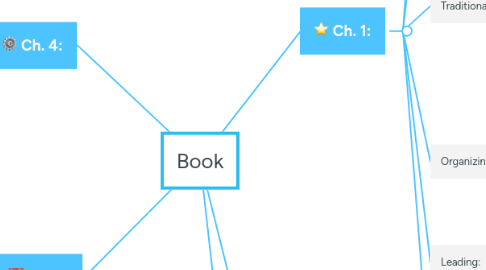
1. Ch. 4:
1.1. Project Manager
1.2. Team Members
1.3. Budget
1.4. Assets
2. Ch. 5:
2.1. Project Start
2.1.1. Project specifications
2.1.2. End User requirements
2.1.3. Action points sign-off
2.2. Phase 1
2.2.1. Top Priorities
2.2.2. Medium Priorities
2.2.3. Low Priorities
2.3. Phase 2
2.3.1. Top Priorities
2.3.2. Medium Priorities
2.3.3. Low Priorities
2.4. Phase 3
2.4.1. Top Priorities
2.4.2. Medium Priorities
2.4.3. Low Priorities
3. Ch. 3:
3.1. Budget
3.1.1. Materials
3.1.2. Personnel
3.1.3. Services
3.1.4. Duration
3.2. Deadline
3.3. Requirements
4. Ch. 1:
4.1. Who are managers:
4.1.1. "A person responsible for controlling or administering all or part of a company or similar organization."
4.2. Types of managers:
4.2.1. Top managers
4.2.1.1. "a person responsible for controlling or administering all or part of a company or similar organization..."
4.2.2. Functional managers
4.2.2.1. "...responsible for the efficiency and effectiveness of an area, such as accounting or marketing."
4.2.3. Team managers
4.2.3.1. "...responsible for coordinating a subgroup of a particular division or a team composed of members from different parts of the organization."
4.3. Traditional vs. Contemporary:
4.3.1. Traditional: "Top managers ensures the organization's competitiveness and lower level managers' and employees' job security. Lower-level managers and employees implement top management's strategy with loyalty and obedience."
4.3.2. Contemporary: "Empowered lower-level managers and employees are responsible for the organization's competitiveness and their own development. Top management support personnel development and ensure employability."
4.4. Organizing:
4.4.1. "Organizing is the function of management that involves developing an organizational structure and al-locating human resources to ensure the accomplishment of objectives."
4.5. Leading:
4.5.1. "Leading involves the social and informal sources of influence that you use to inspire action taken by others. If managers are effective leaders, their subordinates will be enthusiastic about exerting effort to attain organizational objectives."
4.6. Controlling:
4.6.1. "Controlling involves ensuring that performance does not deviate from standards. Controlling consists of three steps, which include (1) establishing performance standards, (2) comparing actual performance against standards, and (3) taking corrective action when necessary."

